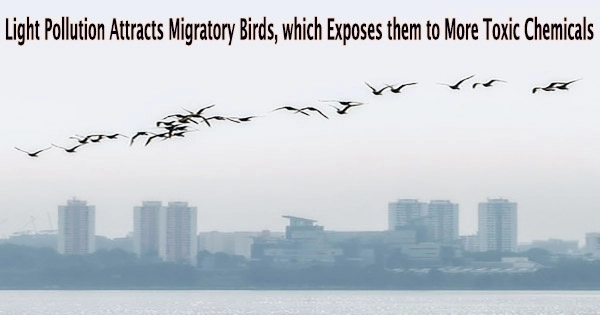Night migrating birds already face dangers on their flights. Beyond the increased risk of collisions with structures or communication towers, light pollution adds yet another concern.
A recent study found that birds are drawn to regions with higher levels of airborne harmful substances when they are attracted to the glow of artificial light at night. A recent publication of the study in the journal Global Change Biology.
“We examined the correlation between the concentration of airborne toxic chemicals, artificial light at night, and the weekly abundance of 165 nocturnally migrating songbird species,” said lead author Frank La Sorte at the Cornell Lab of Ornithology.
“What we found is that light pollution does indeed increase exposure to toxic chemicals when birds stop to rest during spring and fall migration. Surprisingly, we also found that exposure to toxic chemicals is high during the non-breeding season, a time when birds typically avoid light pollution.”
One region of special concern is along the Gulf of Mexico, especially in Texas and Louisiana. Migratory birds that spend the winter in this region are being exposed to higher concentrations of airborne toxic chemicals for a longer period the non-breeding season makes up the largest portion of these species’ annual life cycles.
Frank La Sorte
The researchers initially examined the prevalence of 479 harmful compounds from 15,743 emitting facilities across the continental United States with levels of artificial light at night. They discovered a correlation between increased amounts of airborne hazardous compounds and increased light pollution. The researchers then used information from the Cornell Lab’s eBird initiative to cross-reference this data with the weekly abundance of 165 night-migrating songbird species throughout their yearlong life cycles.
During the breeding season, when songbirds normally build their nests in settings far from areas of busy human activity, the only time that did not show an increase in exposure to harmful chemicals.
“One region of special concern is along the Gulf of Mexico, especially in Texas and Louisiana,” said La Sorte. “Migratory birds that spend the winter in this region are being exposed to higher concentrations of airborne toxic chemicals for a longer period the non-breeding season makes up the largest portion of these species’ annual life cycles.”
According to studies, air pollution has caused some species to stop migrating, vary the altitude at which they migrate, or change their trajectory altogether. Long-term contact with harmful substances can affect how cells and organs work, and contamination can reach young through the transfer of substances from a nesting female to her eggs.
The study’s findings demonstrate how volunteer eBird participants’ observations are enabling researchers to gain a more comprehensive understanding of the effects of light pollution on nocturnal migratory birds.
“Efforts to reduce light pollution during the spring and autumn would reduce the chances of toxic chemical contamination during migration stopovers, which would improve survival and reproductive success,” La Sorte said.
“However, this would have no effect on the long-term exposure occurring along the U.S. Gulf Coast, a region that could be a significant source of toxic chemical contamination for North American birds.”





